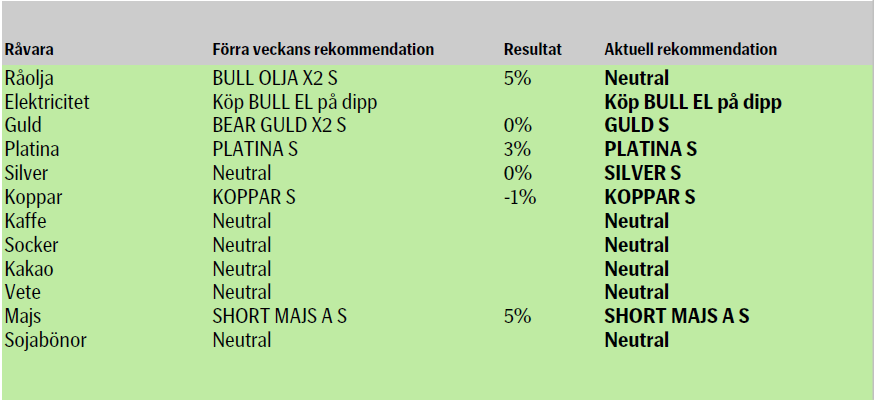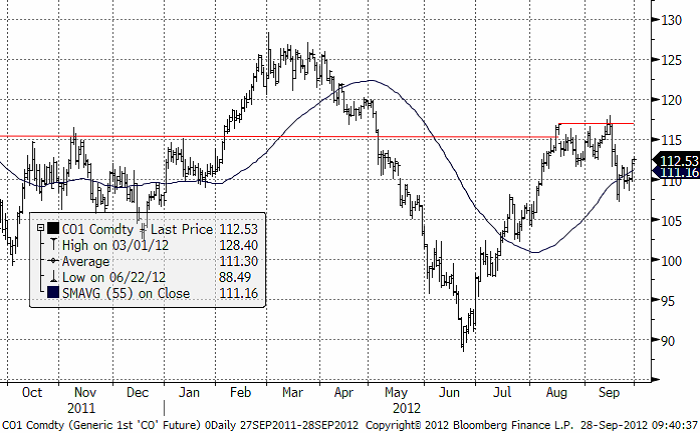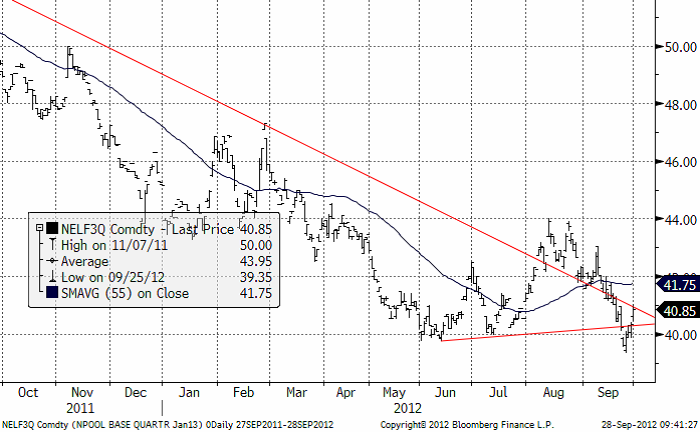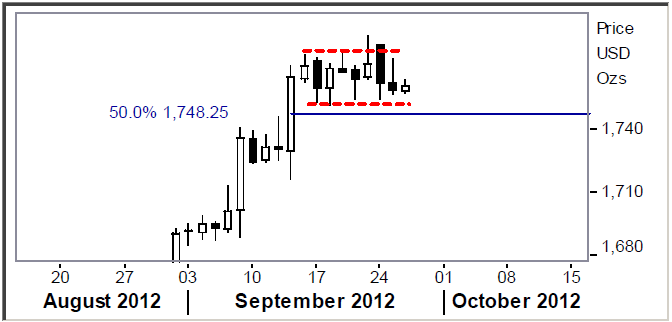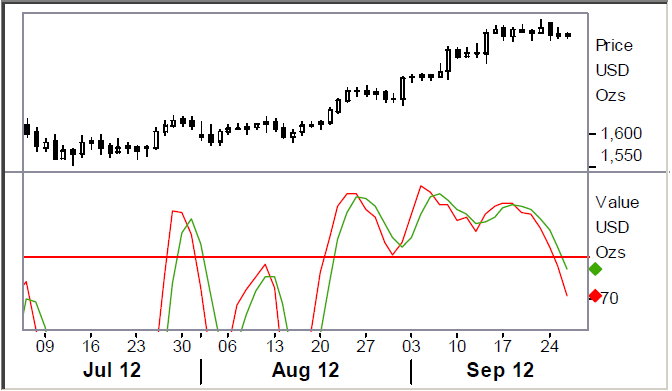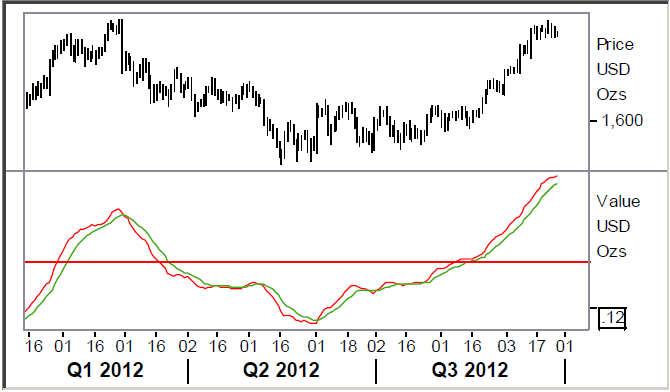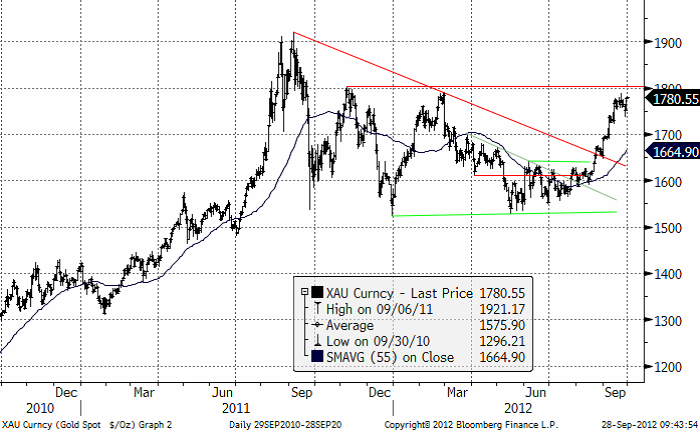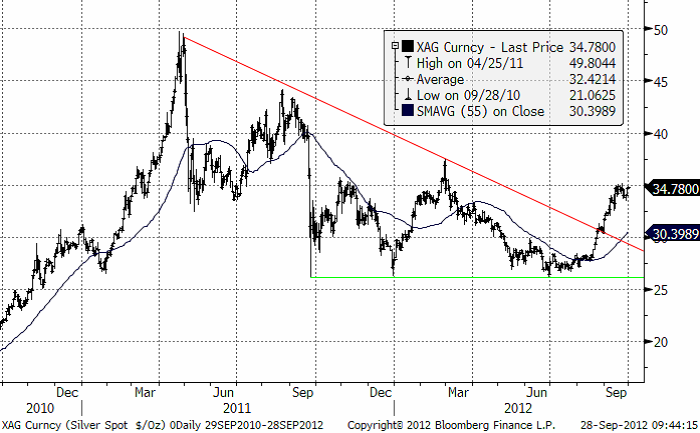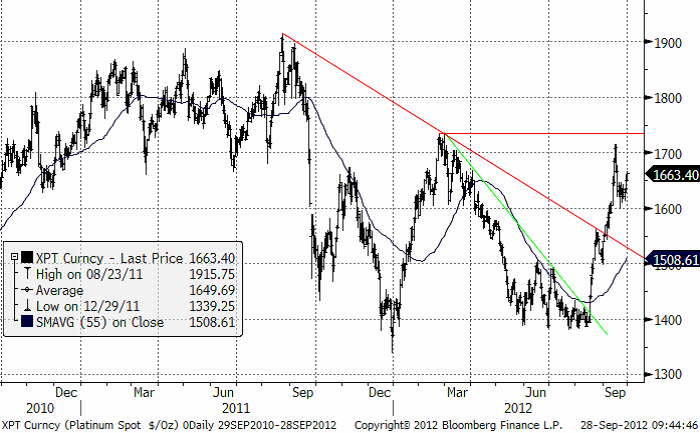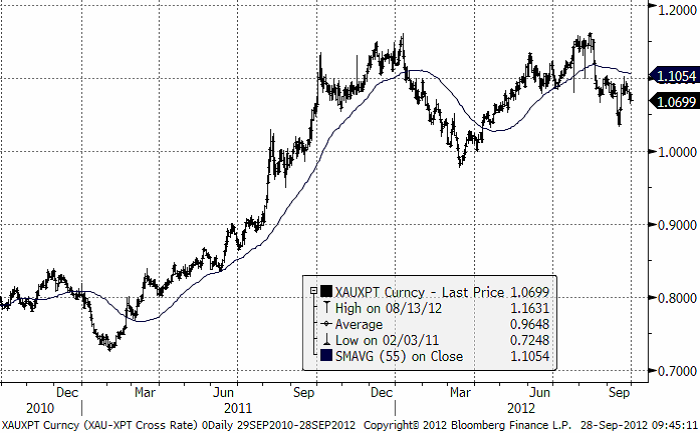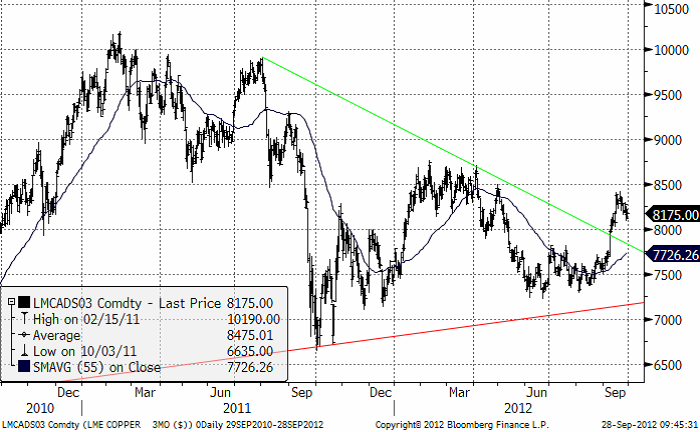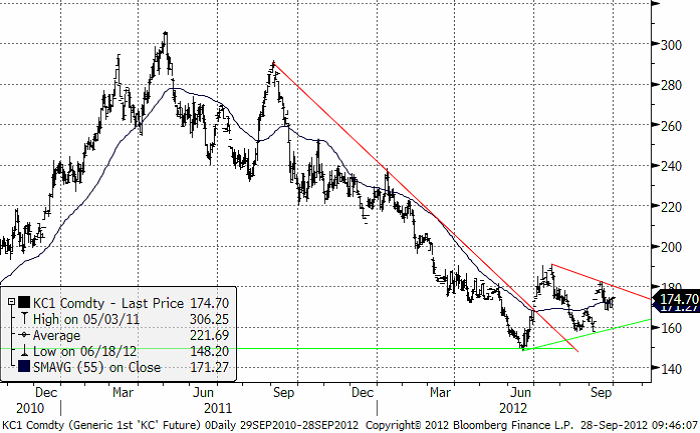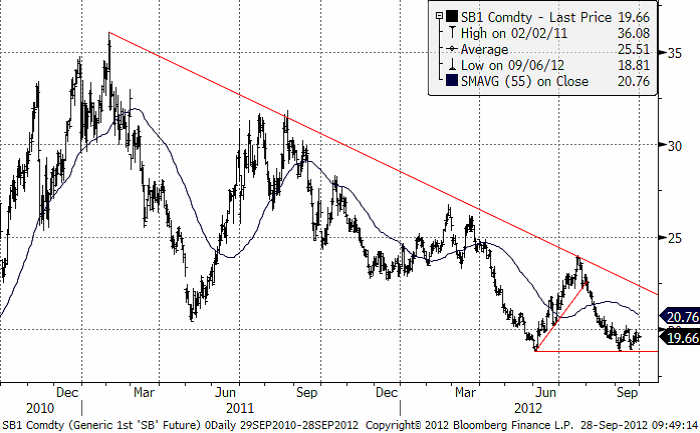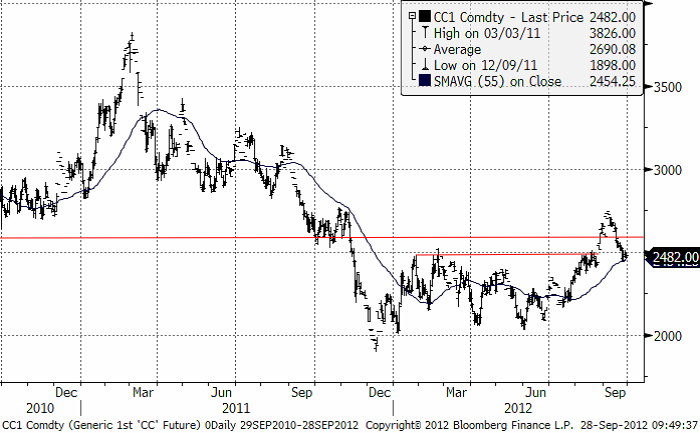Analys
SEB – Råvarukommentarer, 28 september 2012
Sammanfattning av rekommendationer
Summan av resultatet blev vinst på 12%, efter förra veckans förlust på -1%.
Viktigast den här veckan är att vi tror att det kan komma en rekyl i guldpriset. Det ser ut så rent tekniskt. Priset har rusat iväg väldigt fort och är uppe på nivåer där det sannolikt finns många som vill ta hem vinster. Vi ser detta som en teknisk och kortsiktig rekyl. Vi anser att det finns gott om värde i Platina och väljer att ligga kvar köpta den, samtidigt som vi mycket kortsiktigt rekommenderar en kort position i guld. Råolja går vi över till neutral rekommendation på, liksom på silver, som ligger någonstans mellan guld och platina i vår vy nu.
Jordbruksprodukterna är vi neutrala till negativa till. Det kommer viktig lagerstatistik från USDA senare idag, som är värt att hålla koll på. Kaffe, socker och kakao ligger alla lågt i pris, och tycks bilda bottenformationer inför en eventuell trendvändning. För närvarande är vi neutrala.
Råolja – Brent
Det blev ingen omedelbar prisuppgång i Brentolja efter USAs tredje omgång av kvantitativa lättnader. Brentoljan faktiskt har fallit snarare än motsatsen. Den främsta orsaken till detta är på den ökande oron över situationen i Europa vilket resulterar i en starkare USD och en svagare euro. Medan Mellanösterns försörjningsavbrott och olösta situationen håller oljepriset sig högt men den grundläggande makrobilden ser svag ut och drar i baisseriktning. Vi har en neutral syn på Brentolja för närvarande till ett pris av $ 110 / b. Saudiarabien skulle gärna se att oljepriset blev lägre i syfte att lindra den globala makrosituationen men har inte lyckats hittills. Saudiarabien fortsätter dock att försöka hålla ner oljepriset genom att hålla sin oljeproduktion på en förhöjd nivå.
I nuläget förhåller vi oss neutral men ser nivåer kring 105 USD som en mycket attraktiv nivå för en lång position.
Elektricitet
Elmarknaden föll genom stödet, men vände sedan upp igen och ligger nu precis under motståndet. Den kortsiktiga trenden är nedåtriktad och vi ser uppgången som en rekyl. Ser vi till marknaden för kol, vars pris helt och hållet styr priset på el i Norden, är den marknaden i en tydlig nedåttrend sedan en topp i början på augusti. Däremot är priset på kol nere på en nivå, där priset funnit stöd flera gånger förut, i maj, juni och juli. Marknaden testar alltså historiska bottennivåer i såväl kol som el. Vi har ännu inte en köprekommendation, utan behåller neutral rekommendation.
Vidare kan nämnas att väderleksrapporten visar riklig nederbörd, reservoarerna är på 5-årshögsta och hydrobalansen är 12 till 15 TWh över det normala. Nordiska kärnkraftverk väntas vara helt online från den 26 oktober och global ekonomisk aktivitet minskar såväl i Asien som i Europa och är svag och oförutsägbar i USA. Detta gör att vi är oroliga för ytterligare nedsida i elpriset. Icke desto mindre, handlas kontraktet för det första kvartalets genomsnittliga spotpris för 2013, som är underliggande för våra ETN:er, nära 40 euro per MWh, som vi anser är ett bra pris inför vintern. Första kvartalet är trots allt det kallaste kvartalet. Det finns möjligheter till kortsiktiga uppgångar till 44 euro.
Guld och Silver
Efter den initiala reaktionen efter FED har guld och silver inte orkat klättra vidare. Många aktörer som köpt på förväntningar om ytterligare stimulanser har legat beredda att ta hem vinster. Det gamla ordspråket ”buy the rumour and sell the fact” verkar gälla även den här veckan. Undertonen är ändå stark och rekylerna endast marginella. Vi bedömer att priserna har fortsatt mer att ge med nivån $1800 inom räckhåll för guld (spot i London handlas kring $1862 i skrivandes stund). En tänkbar strategi (för den som inte redan köpt) är att bevaka den tidigare högsta nivån $1780 och agera på ett genombrott. Scenariot är likartat för silver med rekommenderad bevakning av förra veckans toppnivå på $35/oz ($34,50 i skrivandes stund). Vår tekniska analys indikerar en större rekyl på nedsidan om nivån 1748 bryts på stängningsbasis. Se våra tekniska kommentarer nedan:
Bankens tekniska analytiker menar så här: “Last Friday printed an up-thrust top, a false break higher. The move was on Monday followed by a gap higher and an immediate reversal creating a bearish engulfing/key day reversal candle. A break below 1752 will confirm at least a short term top formation (and more so breaking below the mid body pt, 1748, of the latest rising benchmark candle).” Dessutom ser man en divergens mellan den tekniska indikatorn stochastics, som ofta används som en överköpt/översåldindikator:
“There is a confirmed bear divergence between price and stochastic i.e. a higher top in price and a lower one in the indicator”. Vi ser en bild på detta nedan:
En annan teknisk indikator, MACD, visar på en överköpt marknad, som vi ser i nedanstående diagram, samtidigt som priset på guld ligger väldigt nära toppnivåerna från det första kvartalet.
Nedan ser vi lite längre historik för guld i dollar per troy ounce.
Nedan ser vi kursdiagrammet för silver i dollar per troy ounce, som ligger precis under 35 dollar. Vi har sett att det verkar finnas säljare på 35 dollar.
Platina
Trots strejkslutet vid Lonmins gruva i Sydafrika vände marknaden uppåt i veckan. Spotnoteringen i London är upp ca 1,5 % sen förra fredagen. Lonmin har finansiella problem och strejkvågen riskerar att sprida sig till andra platinagruvor. Flera guldgruvor har produktionsstopp p.g.a. nya strejker. Risken är stor för minskat utbud från regionen. Den industriella efterfrågan är relativt svag i Europa men fordonsindustrin i Kina förväntas skapa god tillväxt. Vi kvarstår med köprekommendationen.
Nedan ser vi priset på guld dividerat med priset på platina. Vi ser att guld har utvecklats sämre än platina sedan mitten avaugusti. Tekniskt ser den här trenden stark ut och har potential att gå från 1.05 till 1, dvs en outperformance på ytterligare 7%till platinas fördel. Som vi ser av den längre historiken brukar platina vara betydligt dyrare än guld. Dagens rabatt på platina iförhållande till guld är väldigt ovanlig.
Koppar
Prisutvecklingen har varit lite ”tråkig” för basmetallerna under veckan. Fokus har återigen skiftat tillbaka till Europa. Preliminära PMI- siffror från Eurozonen kom in lägre än väntat, 45,9 mot 46,3 förra månaden. IFO-Index (företagsklimatet) från Tyskland ingav inte heller något ökat förtroende. Ingen viktig statistik från Kina, men marknaden känner sig tveksam till aktiviteten där just nu. Det är egentligen bara US som faktiskt visar positiva tecken, på den för den amerikanska ekonomin så viktiga bostadsmarknaden, som nu verkar ha bottnat ur.
Basmetallerna handlades med blandad tendens under veckan. Koppar föll, aluminium och zink höll sig oförändrade, medan nickel visar styrka just nu och är upp 2 %.
När det gäller koppar, räknade vi med en stabilisering efter rekylen i förra veckan och därefter nya försök på uppsidan, men marknaden har inte haft kraft nog. Priset har istället fallit ca 1 %. Vi kvarstår med bedömningen att det mesta talar för en fortsatt stark underton. Den kan dock dröja lite till innan en ny rusning. Nya signaler från Kina är nog vad som behövs. Kina konsumerar 40 % av världens koppar.
Vi bedömer att finansiella aktörer som tidigare spekulerat i nedgång, nu har återköpt positioner. Tekniska fonder har börjat gå långa. Industrin är än så länge avvaktande och brottas med en prisuppgång som inte riktigt speglar den fundamentala situationen, och i många fall överstiger lagda budgetnivåer. Frågan är när (och om) industrin tvingas ”bita i det sura äpplet” och täcka in framtida behov. Centralbankerna visar att de menar allvar och stimulanserna fortsätter. Aktörerna väntar på mer från Kina. Mycket talar för en fortsatt stark trend i nästa vecka med test av nivåer upp mot $8500.
Vi väljer att på kort sikt rekommendera en lång position i koppar.
Kaffe
Kaffepriset har rekylerat ner från toppen tidigare i månaden, men funnit stöd vid 55 dagars glidande medelvärde. Tekniskt noterar vi att det efter bottennoteringen i juni på 148 cent, har en tid av konsolidering i marknaden bildat en triangelformation. Triangelformationer kan ofta signalera en trendvändning uppåt, som bekräftas av ett brott uppåt i så fall. Triangelformationen är ett observandum. Vi behåller en neutral rekommendation i väntan på brott uppåt – eller nedåt från formationen, som du kan se inritad i diagrammet nedan.
Socker
Marknaden för socker pressas av ideliga dåliga nyheter. Till exempel väntas nu det tredje året med överskott (lageruppbyggnad) pga hög produktion. Priset tycks dock inte ta mycket intryck av detta, utan håller det tekniska stödet, än så länge.
Kakao
Kakaopriset har fortsatt falla ner mot stödområdet. Vi behåller förra veckans neutrala rekommendation.
Stocks report idag från det amerikanska jordbruksdepartementet
Idag, fredag publicerar USDA stocksrapporten per den 1 september. Vi har sammanställt marknadens förväntningar från analytikers bidrag till Bloomberg och du ser dem i tabellen nedan:
 För spannmål och övriga jordbruksprodukter hänvisas till gårdagens nyhetsbrev om jordruksprodukter.
För spannmål och övriga jordbruksprodukter hänvisas till gårdagens nyhetsbrev om jordruksprodukter.
[box]SEB Veckobrev Veckans råvarukommentar är producerat av SEB Merchant Banking och publiceras i samarbete och med tillstånd på Råvarumarknaden.se[/box]
Disclaimer
The information in this document has been compiled by SEB Merchant Banking, a division within Skandinaviska Enskilda Banken AB (publ) (“SEB”).
Opinions contained in this report represent the bank’s present opinion only and are subject to change without notice. All information contained in this report has been compiled in good faith from sources believed to be reliable. However, no representation or warranty, expressed or implied, is made with respect to the completeness or accuracy of its contents and the information is not to be relied upon as authoritative. Anyone considering taking actions based upon the content of this document is urged to base his or her investment decisions upon such investigations as he or she deems necessary. This document is being provided as information only, and no specific actions are being solicited as a result of it; to the extent permitted by law, no liability whatsoever is accepted for any direct or consequential loss arising from use of this document or its contents.
About SEB
SEB is a public company incorporated in Stockholm, Sweden, with limited liability. It is a participant at major Nordic and other European Regulated Markets and Multilateral Trading Facilities (as well as some non-European equivalent markets) for trading in financial instruments, such as markets operated by NASDAQ OMX, NYSE Euronext, London Stock Exchange, Deutsche Börse, Swiss Exchanges, Turquoise and Chi-X. SEB is authorized and regulated by Finansinspektionen in Sweden; it is authorized and subject to limited regulation by the Financial Services Authority for the conduct of designated investment business in the UK, and is subject to the provisions of relevant regulators in all other jurisdictions where SEB conducts operations. SEB Merchant Banking. All rights reserved.
Analys
Tightening fundamentals – bullish inventories from DOE

The latest weekly report from the US DOE showed a substantial drawdown across key petroleum categories, adding more upside potential to the fundamental picture.

Commercial crude inventories (excl. SPR) fell by 5.8 million barrels, bringing total inventories down to 415.1 million barrels. Now sitting 11% below the five-year seasonal norm and placed in the lowest 2015-2022 range (see picture below).
Product inventories also tightened further last week. Gasoline inventories declined by 2.1 million barrels, with reductions seen in both finished gasoline and blending components. Current gasoline levels are about 3% below the five-year average for this time of year.
Among products, the most notable move came in diesel, where inventories dropped by almost 4.1 million barrels, deepening the deficit to around 20% below seasonal norms – continuing to underscore the persistent supply tightness in diesel markets.
The only area of inventory growth was in propane/propylene, which posted a significant 5.1-million-barrel build and now stands 9% above the five-year average.
Total commercial petroleum inventories (crude plus refined products) declined by 4.2 million barrels on the week, reinforcing the overall tightening of US crude and products.


Analys
Bombs to ”ceasefire” in hours – Brent below $70

A classic case of “buy the rumor, sell the news” played out in oil markets, as Brent crude has dropped sharply – down nearly USD 10 per barrel since yesterday evening – following Iran’s retaliatory strike on a U.S. air base in Qatar. The immediate reaction was: “That was it?” The strike followed a carefully calibrated, non-escalatory playbook, avoiding direct threats to energy infrastructure or disruption of shipping through the Strait of Hormuz – thus calming worst-case fears.

After Monday morning’s sharp spike to USD 81.4 per barrel, triggered by the U.S. bombing of Iranian nuclear facilities, oil prices drifted sideways in anticipation of a potential Iranian response. That response came with advance warning and caused limited physical damage. Early this morning, both the U.S. President and Iranian state media announced a ceasefire, effectively placing a lid on the immediate conflict risk – at least for now.
As a result, Brent crude has now fallen by a total of USD 12 from Monday’s peak, currently trading around USD 69 per barrel.
Looking beyond geopolitics, the market will now shift its focus to the upcoming OPEC+ meeting in early July. Saudi Arabia’s decision to increase output earlier this year – despite falling prices – has drawn renewed attention considering recent developments. Some suggest this was a response to U.S. pressure to offset potential Iranian supply losses.
However, consensus is that the move was driven more by internal OPEC+ dynamics. After years of curbing production to support prices, Riyadh had grown frustrated with quota-busting by several members (notably Kazakhstan). With Saudi Arabia cutting up to 2 million barrels per day – roughly 2% of global supply – returns were diminishing, and the risk of losing market share was rising. The production increase is widely seen as an effort to reassert leadership and restore discipline within the group.
That said, the FT recently stated that, the Saudis remain wary of past missteps. In 2018, Riyadh ramped up output at Trump’s request ahead of Iran sanctions, only to see prices collapse when the U.S. granted broad waivers – triggering oversupply. Officials have reportedly made it clear they don’t intend to repeat that mistake.
The recent visit by President Trump to Saudi Arabia, which included agreements on AI, defense, and nuclear cooperation, suggests a broader strategic alignment. This has fueled speculation about a quiet “pump-for-politics” deal behind recent production moves.
Looking ahead, oil prices have now retraced the entire rally sparked by the June 13 Israel–Iran escalation. This retreat provides more political and policy space for both the U.S. and Saudi Arabia. Specifically, it makes it easier for Riyadh to scale back its three recent production hikes of 411,000 barrels each, potentially returning to more moderate increases of 137,000 barrels for August and September.
In short: with no major loss of Iranian supply to the market, OPEC+ – led by Saudi Arabia – no longer needs to compensate for a disruption that hasn’t materialized, especially not to please the U.S. at the cost of its own market strategy. As the Saudis themselves have signaled, they are unlikely to repeat previous mistakes.
Conclusion: With Brent now in the high USD 60s, buying oil looks fundamentally justified. The geopolitical premium has deflated, but tensions between Israel and Iran remain unresolved – and the risk of missteps and renewed escalation still lingers. In fact, even this morning, reports have emerged of renewed missile fire despite the declared “truce.” The path forward may be calmer – but it is far from stable.
Analys
A muted price reaction. Market looks relaxed, but it is still on edge waiting for what Iran will do

Brent crossed the 80-line this morning but quickly fell back assigning limited probability for Iran choosing to close the Strait of Hormuz. Brent traded in a range of USD 70.56 – 79.04/b last week as the market fluctuated between ”Iran wants a deal” and ”US is about to attack Iran”. At the end of the week though, Donald Trump managed to convince markets (and probably also Iran) that he would make a decision within two weeks. I.e. no imminent attack. Previously when when he has talked about ”making a decision within two weeks” he has often ended up doing nothing in the end. The oil market relaxed as a result and the week ended at USD 77.01/b which is just USD 6/b above the year to date average of USD 71/b.

Brent jumped to USD 81.4/b this morning, the highest since mid-January, but then quickly fell back to a current price of USD 78.2/b which is only up 1.5% versus the close on Friday. As such the market is pricing a fairly low probability that Iran will actually close the Strait of Hormuz. Probably because it will hurt Iranian oil exports as well as the global oil market.
It was however all smoke and mirrors. Deception. The US attacked Iran on Saturday. The attack involved 125 warplanes, submarines and surface warships and 14 bunker buster bombs were dropped on Iranian nuclear sites including Fordow, Natanz and Isfahan. In response the Iranian Parliament voted in support of closing the Strait of Hormuz where some 17 mb of crude and products is transported to the global market every day plus significant volumes of LNG. This is however merely an advise to the Supreme leader Ayatollah Ali Khamenei and the Supreme National Security Council which sits with the final and actual decision.
No supply of oil is lost yet. It is about the risk of Iran closing the Strait of Hormuz or not. So far not a single drop of oil supply has been lost to the global market. The price at the moment is all about the assessed risk of loss of supply. Will Iran choose to choke of the Strait of Hormuz or not? That is the big question. It would be painful for US consumers, for Donald Trump’s voter base, for the global economy but also for Iran and its population which relies on oil exports and income from selling oil out of that Strait as well. As such it is not a no-brainer choice for Iran to close the Strait for oil exports. And looking at the il price this morning it is clear that the oil market doesn’t assign a very high probability of it happening. It is however probably well within the capability of Iran to close the Strait off with rockets, mines, air-drones and possibly sea-drones. Just look at how Ukraine has been able to control and damage the Russian Black Sea fleet.
What to do about the highly enriched uranium which has gone missing? While the US and Israel can celebrate their destruction of Iranian nuclear facilities they are also scratching their heads over what to do with the lost Iranian nuclear material. Iran had 408 kg of highly enriched uranium (IAEA). Almost weapons grade. Enough for some 10 nuclear warheads. It seems to have been transported out of Fordow before the attack this weekend.
The market is still on edge. USD 80-something/b seems sensible while we wait. The oil market reaction to this weekend’s events is very muted so far. The market is still on edge awaiting what Iran will do. Because Iran will do something. But what and when? An oil price of 80-something seems like a sensible level until something do happen.
-

 Nyheter4 veckor sedan
Nyheter4 veckor sedanStor uppsida i Lappland Guldprospekterings aktie enligt analys
-

 Nyheter4 veckor sedan
Nyheter4 veckor sedanSilverpriset släpar efter guldets utveckling, har mer uppsida
-

 Nyheter3 veckor sedan
Nyheter3 veckor sedanUppgången i oljepriset planade ut under helgen
-

 Nyheter3 veckor sedan
Nyheter3 veckor sedanLåga elpriser i sommar – men mellersta Sverige får en ökning
-

 Nyheter2 veckor sedan
Nyheter2 veckor sedanMahvie Minerals växlar spår – satsar fullt ut på guld
-

 Analys3 veckor sedan
Analys3 veckor sedanVery relaxed at USD 75/b. Risk barometer will likely fluctuate to higher levels with Brent into the 80ies or higher coming 2-3 weeks
-

 Nyheter1 vecka sedan
Nyheter1 vecka sedanOljan, guldet och marknadens oroande tystnad
-

 Nyheter1 vecka sedan
Nyheter1 vecka sedanJonas Lindvall är tillbaka med ett nytt oljebolag, Perthro, som ska börsnoteras



